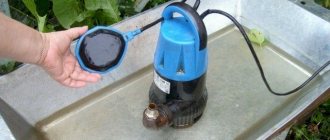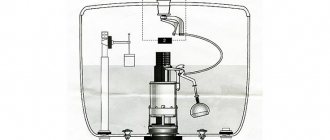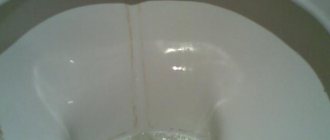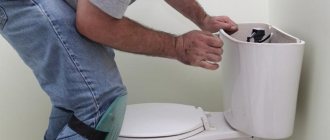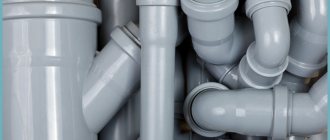Even with reliable equipment from well-known brands, problems can happen. If your LG washing machine does not drain water, then do not rush to contact the service center. Indeed, in some cases you can solve the problem on your own.
To do this, you need to understand the structure of the main technical components and the operating principle of the washing machine. Let's look at what to do next.
- How are problems with drainage expressed?
- Causes
- Water drain options
- Troubleshooting
- Catalog of LG washing machines with reviews
Online diagnostics of a washing machine
If your machine stops washing or rinsing clothes normally, then some kind of malfunction or breakdown has occurred.
You can try to find the problem yourself. Run diagnostics
Select which operation your washing machine does not perform:
1. Doesn’t drain 2. Doesn’t rotate the drum 3. Doesn’t spin clothes 4. Noises, knocks, buzzes when spinning 5. Doesn’t turn on
Checking the operation of the drain pump Is the drain pump of the washing machine working? Yes No I don’t know << Back
Clogged hoses in the washing machine If the sound corresponds to the normal sound that has always been observed when the device is working, the cause is probably a clog.
Was there a blockage in the drain hose? Yes
<< Back
The drain pump does not work! If the sound matches the normal sound of the drain pump, it is recommended that you check the drain filter first.
After cleaning, does the drain pump work and does the washing machine drain water? Not really
<< Back
Operation of the drain pump The sound of the pump is usually immediately audible and noticeable. If there is no sound, the pump is not working. We are looking for how to separately enable the water drainage program. As a rule, this is a separate option. After the program has been turned on, the pump should start working in 1-3 seconds. If everything is done correctly and the pump is operational, a buzzing sound will appear. If you hear no buzzing or other sounds when you turn on the program, the pump is probably faulty.
Is the washing machine drain pump working? Not really
<< Back
Clogged car hoses If you have identified a clog in the hoses, you need to disassemble them, clean them, and then reassemble everything.
Does the washing machine drain well? Not really
<< Back
Hurray, you did a great job, you fixed it.
<< Return to the beginning of diagnostics
The drain pump is faulty, call a professional.
<< Return to the beginning of the diagnosis.
The washing machine does not rotate the drum. During the operation of the washing machine, such a problem may occur. Each model has a different drum operation. It rotates according to a given algorithm, which is set by the program. This principle applies to spinning and washing. If you are not sure whether the drum is not spinning or whether it is working, put the laundry in the washing machine. Start the spin program. If the machine is running, it will first drain the water and then start spinning. In this case, a rotational process will be observed. If rotation is not visible, then check the belt. First, turn off the program, then unplug the wire from the outlet so that power does not flow into the device. Now you need to remove the back cover. You will need to carefully inspect the drum belt. It is quite easy to determine whether it is in the wrong position or damaged.
Is the washing machine belt torn or stretched? Not really
<< Back
Broken drum drive belt If the belt breaks, it will be immediately visible. There are also often cases when the belt simply stretches, which is why the drum, accordingly, does not rotate. Do not allow the machine to operate if the belt breaks. It is important to check whether it has wound around the engine pulley or broken the wiring to the engine. The heating element and temperature sensor may also be damaged if the belt does catch the wires. It is imperative to ensure that the belt model is original. If you choose an unsuitable or low-quality product, this will affect the performance of other devices. How do you know what kind of belt you have? There will be a marking written on the old one, compare it with the one indicated on the belt offered to you. You can also find out belt information by car model.
<< Return to the beginning of the diagnosis.
Washing machine motor malfunction If a malfunction is not found, the block with wires must be disconnected from the electric motor. Carefully remove it. We visually evaluate the engine. It may have melting, cracks, or other effects that clearly indicate damage. We call the windings of the tachogenerator and the engine. It is important to understand that you can fully study how correctly the engine operates and whether there is a malfunction only at the stand. If rotation does not occur, there may be a problem with more than just the motor. Sometimes the cause is a malfunctioning electronic module. If a short circuit occurs in the engine, the module could be damaged, while the engine remains operational. Also, the wires could be damaged.
<< Return to the beginning of the diagnosis.
Repairing a washing machine that does not spin clothes After completing the washing process, the washing machine may not spin properly or may not start spinning. Firstly, look, perhaps another mode is set, which does not involve turning on the spin cycle at all. This happens, for example, with programs related to washing woolen items and delicate fabrics. To check, run the spin cycle separately. If the washing machine does not drain water, we proceed to check the pump.
Does the washing machine now spin clothes? Not really
<< Back
Congratulations, you have solved your problem!
<< Return to the beginning of the diagnosis.
Repair of washing machines, imbalance Modern washing machines place the laundry on the drum before spinning. This is necessary for quality work. Check if this feature works. Sometimes a situation occurs when things get wrapped up in a ball that cannot be unwound automatically within a certain time. At this point the work stops. You need to unwind this laundry yourself, lay it out and continue operating the washing machine. In this case, it is important to turn off the machine, and then, when the laundry is laid out, turn on a separate spin program.
Does the washing machine now spin clothes? Not really
<< Back
Washing machine repair, drum drive repair Now you need to check the drum drive belt. We remove the cover and visually assess the condition of the belt. There should be no damage. If the tension is weak, the spin may not turn on. If you need to replace the belt, you should only replace it with the original one. After replacing, we try the program again.
Fault found, does the washing machine spin? Not really
<< Back
The engine or electronic module is faulty, call a repairman to your home.
<< Return to the beginning of the diagnosis.
The washing machine hums, makes noise during the spin cycle, rumbles, and makes a jet plane noise. If the washing machine makes noise during operation, making unusual sounds, it’s time to pay special attention to it. In this case, a visible breakdown or lack of functionality may not be observed, but the appearance of strange sounds indicates that it is time to look for a malfunction. It is important to understand that a new car that has just been delivered should be inspected for shipping bolts. If you forget to remove them, noise and vibration are inevitable. So, let's begin! We turn the washing machine drum and listen to extraneous sounds.
When rotating, do you hear extraneous noise, hum, balls rolling, does the drum move unevenly with slight jamming? Not really
<< Back
If the drum rotates and uncharacteristic sounds appear, including vibration, it’s time to check the bearings. If they malfunction, they will have to be replaced.
<< Return to the beginning of the diagnosis.
The counterweight of the washing machine has come loose. The fastening of the counterweights must also be of high quality. If they are “loose”, it’s time to eliminate this defect. In some cases, you can notice that the bolts that secure the stones are completely missing. In this case, the connectors for mounting will be visible. The bolts need to be found and put in place - they probably simply came loose. A rumble heard while the washing machine is operating may indicate that the bolts have partially loosened. To check the bolts, you can simply push the drum. If it is secure, the bolts are fine. If it moves, there is a defect.
Do you hear any noise, clanging or rattling noises when moving the washing machine tub? Not really
<< Back
The counterweight has come off
<< Return to the beginning of diagnostics
Checking the shock absorbers of the washing machine Checking the shock absorbers. If you hear vibration or excessive noise during the spin cycle, there may be a problem with the shock absorbers. Sometimes the washer moves. Now let's check the functionality. Remove the top cover. Click on the tank, move it five to seven centimeters down. A normal reaction will be observed if the tank rises sharply, jumping a little and stopping in its normal place. If this does not happen, the shock absorbers need to be replaced.
Are the shock absorbers of the washing machine working? Not really
<< Back
If a visible defect has not been identified, check whether a foreign object may have entered the machine. Replacing shock absorbers. The problem with shock absorbers wearing out occurs quite often over time.
<< Return to the beginning of the diagnosis.
Replacing washing machine shock absorbers. Malfunction and wear of shock absorbers is a fairly common phenomenon.
<< Return to the beginning of the diagnosis.
The washing machine does not turn on. It is worth trying to find the cause of the problem yourself and fix it. We start by connecting the device to the network. Next, click on the “network” button. In different car models, different indications are triggered: here either the display will start working, or, on the contrary, some other button.
Does the washing machine have an indicator? Not really
<< Back
Hatch lock lock (UBL) You can check it by turning on any of the programs. We choose what we will use. Click on the corresponding button. Don't forget to pay attention to the inclusion. As a rule, the process of activating a function is characterized by the presence of a certain sound, for example a click, with which the device makes it clear that pressing again is not necessary and the machine is already working. If there is no sound, the button may be broken. In this case, the main thing that must be done is to block the hatch and start working. If this happens, everything is fine.
The washing machine is blocking the hatch and the UBL is triggered? Not really
<< Back
Water fill valve malfunction
<< Return to the beginning of the diagnosis.
The washing machine hatch does not lock
<< Return to the beginning of the diagnosis.
No indication Checking the electrical circuit. If you notice that the washing machine does not respond to being turned on, it is first recommended to check the power supply. The outlet may be faulty. Try connecting another device. If the outlet works, you need to check whether the circuit that conducts energy through the washing machine from one element to another is intact. To do this, you will need a multimeter, which will help you fully analyze the ability to respond to an electrical signal at several stages of operation. If there is no network connection anywhere, this is probably the problem. We carry out this manipulation until we reach the electronic module. If we are talking about an old washing machine, here it will look like the device’s program. When you turn on the button, there should be no breaks in the circuit. If the circuit works, everything is fine electrically.
Is the washing machine's power supply OK? Not really
<< Back
Repair of electronic module (unit)
<< Return to the beginning of diagnostics
Contact circuit fault
<< Return to the beginning of diagnostics
In the latter case, make sure that the selected mode includes a spin phase. Some programs for delicate fabrics require gentle rinsing without spinning so that items do not lose their original shape. In such a situation, after the end of the cycle, it is necessary to additionally start draining the water.
Expert opinion
I work in the household appliance repair industry. Extensive experience in restoring washing machines and dishwashers.
Ask a Question
Sometimes, to eliminate a malfunction in the washing machine, it is enough to stop the current program and reboot the system by temporarily disconnecting from the power supply.
Pressostat malfunction
If the drain pump is intact and no blockages are found, you need to proceed to checking the water level sensor. To do this, you need to unscrew two screws from the back of the LG washing machine, slide it back and remove the top cover. In the right corner in the front part of the case, near the control panel, there is a round part with a sensor - a pressure switch. It can be removed very easily, you just need to unscrew the fasteners, disconnect the wiring and remove the hose. You will need to check the device for damage, inspect the hose for blockages and cracks, and also perform wiring diagnostics. If everything is in order, you should move on to the next step.
Causes
Damage to the water level sensor
A faulty pressure switch stops supplying correct data to the control module. Therefore, the system does not drain water. The functionality of the sensor is checked with a multimeter. The faulty part will have to be replaced.
Water level sensor
It is impossible to reliably check the pressure switch at home. But you must understand that this part rarely breaks.
Kinked or clogged drain hose
Not only the filters become clogged with various debris, but also the hose itself for pumping out the waste liquid. As a result, water is not discharged by the system into the sewer system.
The bend of the sleeve also prevents the movement of water. Check and straighten the hose over its entire length.
drain hose
Clogged pipe
The pipe located between the tank and the pump periodically becomes clogged with small debris. Quite often socks get stuck there.
To get to the pipe, you need to partially disassemble the SMA, and in some models, place the machine on its side. Then, you need to remove the clamps from it and remove any accumulations of dirt.
Connection between the tank and the pump volute
Foreign objects in the pump
The washing machine tank is connected to the sewer system using elements such as:
- drain coupling;
- pump pump;
- filters;
- hose.
If one part of the system becomes clogged with debris or foreign objects, malfunction will occur. Note that this happens very often. Therefore, cleaning must be carried out regularly as a preventive measure.
Foreign objects in the pump filter
To do this, you need to unscrew the pump volute cover. Then remove the concentrator and rinse it under high water pressure. Inspect the impeller and the area around it. Remove everything unnecessary.
Expert opinion
I work in the household appliance repair industry. Extensive experience in restoring washing machines and dishwashers.
Ask a Question
Quite often, toothpicks and pins end up here. The pump in almost all washing machines is located at the bottom right, with the exception of the Kandy brand. In models from this company it is located on the left.
Pump failure
Pump volute assembly
This part may burn due to the impeller being clogged with debris. Difficulty in rotation leads to disruption of the unit. In this case, the user can hear a characteristic hum.
It happens that the pump stops draining water due to an air lock that has formed. To eliminate the problem, you need to bleed the system.
Sometimes the pump fails after extending the drain hose and cannot cope with the increased load. Foreign objects also shorten the service life.
Expert opinion
I work in the household appliance repair industry. Extensive experience in restoring washing machines and dishwashers.
Ask a Question
Pumps need to be repaired in rare cases. Usually they are replaced with new parts.
The drain is clogged or the drain siphon is clogged
If you do not find any kinks in the hose, proceed to inspect its junction with the sewer hole. It is worth cleaning the siphon; it is in it that debris from clothing pockets often accumulates.
Connecting the drain via a siphon
Program control unit is faulty
Failure of an electronic module is a serious problem; it occurs for various reasons:
- power surges in the network;
- moisture getting on the board;
- poor-quality soldering of contacts;
- violation of the rules for operating the device.
Only an experienced technician can repair the control unit. Don't try to figure it out on your own without special skills. Unqualified intervention will entail the need to replace the module, and this is a rather expensive part.
Control module
The hub is broken
The concentrator is sometimes called a pump filter. Not all models are equipped with a mesh that blocks the passage of small debris. The concentrator promotes the formation of draft in the cochlea, as a result of which water is pumped out of the tank.
This plastic part wears out over time and becomes brittle from exposure to detergents and impurities from the water supply. In such a situation, a working pump works, but there is no traction.
Pump hub
Quite often there are situations when it is broken when twisted. This happens when foreign objects enter, or when the entire snail sours. This usually occurs due to scale fouling of the node.
A preventative washing cycle without laundry, but with citric acid at high temperature helps solve the problem and remove the part without damage.
Expert opinion
I work in the household appliance repair industry. Extensive experience in restoring washing machines and dishwashers.
Ask a Question
Please note that the concentrator is a cheap spare part, so there is no need to worry if it breaks. And almost anyone can change it.
Reasons for failure and their identification
If the washing machine does not drain water, then the reasons for such a breakdown can be very different. We list them in order of likelihood of their occurrence:
- The drain hose leading from the machine to the sewer is clogged. If a siphon is also included in this chain, then it can also become clogged with debris.
- Filter clogged . The filter can be blocked by coins, pebbles, paper, buttons and other items that were not removed from your pockets in time.
- Something is clogged in the drain pipe, which is located between the washing machine tank and its pump.
Example of a pipe clogged with debris - If the washing machine does not drain water and is humming, then responsible for pumping water failed It consists of an electric motor, a shaft with a plastic impeller and two pipes. The service life of the pump is about 5 years. Often, technicians disassembling the pump find threads and hair wound around the impeller shaft, which were the reasons for the failure. In addition to the engine burning out, the impeller may also break, but the entire assembly changes, in this case, entirely.
- Electronic control module malfunction . Its failure may occur due to power surges or due to natural wear and tear of electronic elements.
- Drain hose is too long. Over time, the power of the drain pump gradually decreases. Usually this power is enough to drain water through a standard hose about 1.5 m long. If a longer hose is used, then the pump may not be physically capable of pumping water over such a distance. Typically, such a failure occurs if the old machine is moved to another place, lengthening the drain hose twice or more.
Drain hose of an automatic washing machine in a siphon
Many modern machines have digital displays that display not only operating modes, but also error codes that occur. Using these codes, using a special table in the instructions, you can determine the nature of the malfunction for more accurate diagnosis.
Some programs installed in washing machines may not provide a spin mode, so the machine waits for an additional command, pausing during the washing process. Therefore, if the washing machine does not drain the water and does not spin, then you need to make sure that the machine is set to the required operating mode.
Important: If the washing machine fills with water and immediately drains it, the reasons may be a failed water level switch, a malfunctioning inlet valve, or a problem with the electronic module. In the latter case, you are unlikely to be able to fix the problem yourself.
Water drain options
You can forcefully get rid of water in the following ways:
- Unscrew the tube cap located next to the filter behind the panel and slowly drain the water.
- Water leaves the washing machine standing on the podium if you disconnect the drain hose from the sewer and place it in a container below the level of the machine. This may not work if there is an “aquastop” - a system that blocks the water supply if there is a leak.
- At the bottom of the front panel of the device there is a filter that periodically becomes clogged with debris. Place a tray under it and unscrew it counterclockwise. The task will be made easier by slightly tilting the body forward.
- By moving the machine away from the wall and removing the back panel, you will get to the tube with a clamp installed under the drum. This pipe needs to be removed and cleaned.
The simplest but most effective method is to scoop water out of the drum with a convenient container. Before opening the door, tilt the body back to avoid flooding the floor. Be on the safe side by placing rags around the car.
Draining water from the SMA
Pump failure
Sometimes the breakdown may lie in the drain pump. A sign of a problem is that the machine does not drain water and makes a humming noise. To check the condition of the pump, inspect the pipe, hose and pump.
To conduct a detailed inspection, the machine is disconnected from the network. Then everything needs to be done according to the algorithm:
- Remove the powder compartment.
- Place the LGI washing machine on the left side where it will be convenient to work with it.
- The clamps at the bottom of the machine are loosened and moved down.
- Remove the pipe and wash it, inspect it for damage and stuck objects. After this, you can return it to its place.
- Disconnect the drain hose and check for blockages.
- Unscrew the pump and remove it.
The pump is opened, dividing it into two parts, and the parts are inspected for the presence of contaminants, such as hair, threads or items of clothing.
If there are no foreign elements on the pump, you need to check whether the electrical part of the part is working. To do this, use a multimeter and put it in resistance testing mode.
The result indicates whether the problem with your washing machine is the pump. If the result is 0 or 1, the part should be replaced. If the multimeter shows a different value than the specified value, there is no problem with this part.
Troubleshooting
Fixing the water drainage problem involves doing the following:
- Disconnect the equipment from the power supply.
- Clean the filter by opening the hatch at the bottom of the front panel of the machine.
- Clear the drain pipe of debris.
- Remove any accumulated hair from the impeller located behind the filter.
- Replace the faulty pump. Check it first with a multimeter.
Measures to replace the pump, if cleaning the impeller of debris does not help, consist of several steps:
- get the snail with the pump;
- remove the wires from the pump;
- install a new one in place of the old part;
- connect the wires;
- put the drain unit back.
After this, you can connect the machine to the network and run a test wash with an empty drum. If the system does not work properly after replacing the pump, contact a specialist.
Most modern models of LG washing machines are equipped with the Smart Diagnosis function. Thanks to it, the necessary information about a malfunction can be transmitted to the service center using a smartphone.
The error displayed on the display can help in solving the problem. The decoding of the codes is in the user manual.
Expensive equipment from a manufacturer with a good reputation sometimes malfunctions and refuses to drain water. When faced with a malfunction in the LG washing machine, inspect all important components one by one to detect blockage or damage. If you are unable to resolve the problem yourself, contact a professional.
Video
General issues
Causes of problems with water drainage:
- The pump hums louder and the water takes longer to drain. At the same time, the laundry is wrung out worse, and the washing time becomes longer than usual.
- If the washing machine becomes louder (it hums or crackles), then the filter is clogged. It needs cleaning.
- If the water does not drain precisely during rinsing, this indicates a failure in the program. The control unit is faulty. The same malfunction is also indicated when the washing machine door does not open periodically.
On a note! You can try unplugging the machine and turning it on again. Perhaps the water will drain automatically when restarting.
Failure of the control board
If the previous steps failed to identify the fault, this may indicate a breakdown of the washing machine control unit. This can happen for a number of reasons:
- Voltage drop, lightning strike.
- The control module tracks are poorly soldered.
- Water getting on board.
- Incorrect actions of the device owner, etc.
You should absolutely not try to repair the control unit yourself. This is a very complex process, during which you can permanently damage your LG washing equipment. To diagnose the board and fix the problem, it is recommended to contact a professional.
Causes of machine malfunction.
Before calling a service technician or disassembling a household unit yourself, let’s try to assess the situation:
- Washing mode. Check the position of the mode switch on the unit. Among the washing options, there are also those that do not include spinning, and, therefore, the laundry remains wet. For example, delicate wash mode. It eliminates spinning so as not to deform the fabric. The washing machine also has a water stop mode. If it is set incorrectly, then press the Start/Pause/Spin button and turn on the water draining program.
- Drain hose. Look at the position he is in. If there is a bend, then the water will have nowhere to go.
- Siphon of the sewer system. The siphon, or even the sewer pipe itself, may become clogged, and then the water from the machine will not be able to drain. Try disconnecting the drain hose from the sewer system and starting the washer. Has the water gone? Then we clean the sewer.
Are the above points not for your case? We are looking for the cause of the breakdown in the technical color of the household appliance.
LG issues an OE code on the display, which you can do yourself
Don't worry ahead of time! It is possible that everything is not so serious, and the OE error can be corrected yourself. Here are the cases in which this can be done.
- The drain filter is clogged. It protects the washing machine pump from large debris from items getting into it. The filter is usually located on the front side in the lower right or left corner behind the hatch. Unscrew it, clean it of debris and screw it back on. From now on, do this regularly. Instructions for removing and cleaning the filter are in the instruction manual for your LG machine. At the same time, look through the hole for the filter into the drain pump. It is possible that a small object got into the impeller and blocked its rotation, so the drain does not work and the LG machine displays an OE error.
- The drain hose is squashed or kinked. Carefully inspect the entire length of the hose. Straighten it if you find kinks, or remove objects that have crushed it.
- The drain is clogged. This often happens when the washing machine drain is connected to the sink siphon. The siphon becomes clogged and the blockage prevents water from flowing out of the machine. Diagnosing a clogged drain is quite simple. Pull the end of the drain hose out of the sewer, place it in any container (bucket, basin, bathtub, toilet) and turn on the drain program. If the water drains normally, it means that everything is in order with the machine, and the cause of the error is a clogged sewer. To fix the problem, you need to clean it.
- There was a failure in the control unit. Unplug your LG washing machine for 10-15 minutes and then turn it on again. Perhaps this will help reset the OE error.
If the points listed above do not work, then some kind of breakdown has occurred and the help of a specialist is required.


